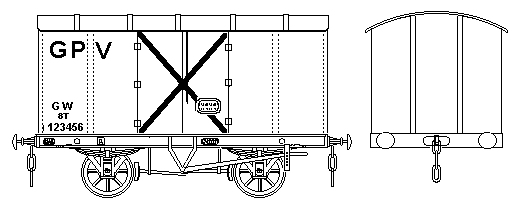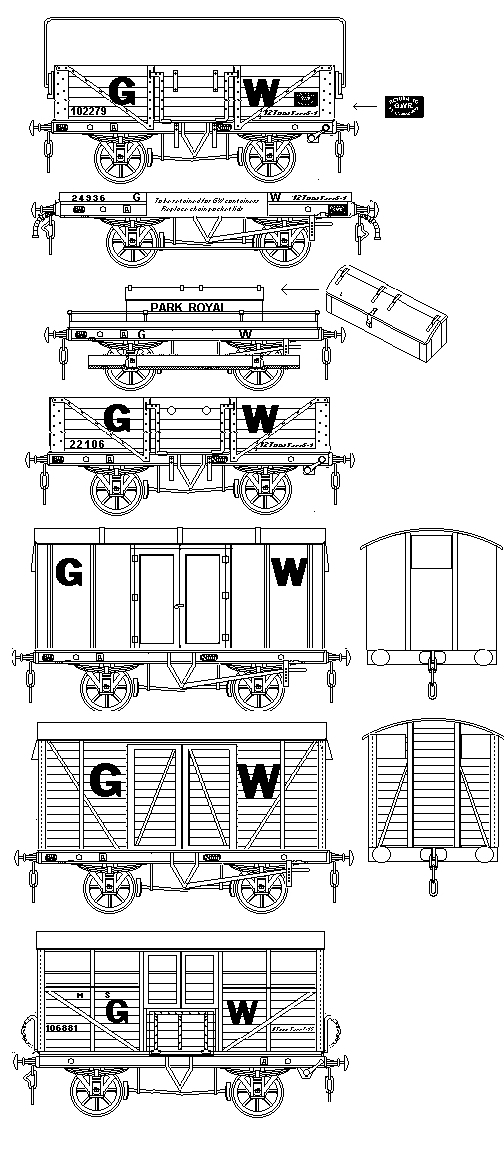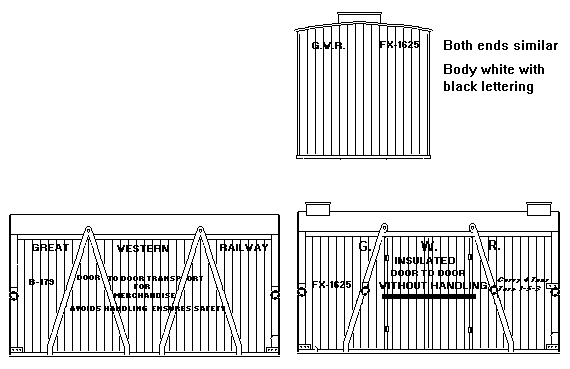
| Return to index page |
Great Western Railway
This company existed prior to the 1923 grouping, the details of the early colours and lettering have been included in the Appendix on pre-grouping liveries. After the grouping the GWR retained its basic pre-grouping livery and applied it to the absorbed stock.
The basic wagon colour was a dark grey for freight stock and plain brown for `non-passenger coaching stock' such as the milk churn vans (coded Siphon for telegraphic purposes), and horse boxes (coded Paco). Underframes were initially black, but some wagons and more particularly vans had the body colour applied to the solebars in later years. The standard for roofs was white, rapidly fading to grey in service. In the late 1930's the GWR changed from red loco lamps to white, which were also subsequently seen on brake vans.
The GWR had standard sizes for its wagon liveries, lettering was white on the grey vehicles, yellow on the brown stock. Where the standard sizes could not be used, on the sides of one plank or Conflat wagons for example, smaller lettering was applied, also where the standard size would cross outside bracing some compromise was usual, although examples where the letters had been painted standard size were to be seen.
Where fitted mineral wagon bottom doors were marked with the open V as described above.
Non common user stock was marked with a plate some 10 inches high by 13 inches wide (25 cm by 33 cm) with `RETURN TO G W R' and `NOT COMMON USER' in the form shown below. This was generally placed to the lower right of the body, but appeared elsewhere in some cases, examples of which have been included in the drawings. This marking remained in use up until Nationalisation in 1947.
Fig ___ GWR Non Common User Plate 
Service stock was painted standard grey but marked P W or PT WAY about 6 inches (15 cm) high (the T was smaller than the P and was underlined as shown). From 1920 was added a circle about a foot (30 cm) across containing the letters CO.
The lettering immediately before the grouping consisted of the initials G and W about 25 inches (64 cm) high with the vehicle number to the lower left of the body and the load and tare to lower right in italic script about six inches (15 cm) high in the form: 12 Tons Tare 6.4. The GW and the vehicle number was repeated on the ends of several vehicles, notably vans and cattle wagons.
In 1920 the size of the G & W was reduced to 16 inches (41 cm) and some brake vans with additional weight fitted were painted with a small white five pointed star below the station name on their sides. Banana vans fitted with steam heating to ripen the fruit in transit now had a white disc about 2 foot (61 cm) in diameter applied in the lower right of the body. This is the white spot incorrectly shown on the Peco van. Stock with this livery, albeit rather faded, was seen as late as the mid 1960's. By the early 1930's the number and GW had disappeared from the ends of stock.
Gunpowder vans were slightly different, the body being painted black or very dark grey. The letters GPV were painted in the upper left of each side, about 18 inches (46 cm) high, on early vans this was repeated on the ends, one letter in each of the end panels near the top and on some vans at least the word GUNPOWDER was painted to the left of the body, halfway up, between the small GW and the GPV. Gunpowder van doors were marked with a red X, the stripes being about four inches (10 cm) wide. An illustration of this livery will be found in GW Wagons Appendix by J. H. Russel, although I have not actually seen this illustration and I believe it may show a converted iron mink van rather than a purpose built gunpowder van. Iron minks converted to this use usually had `IMPROVISED GUNPOWDER VAN', in white letters about 6 inches (15 cm) high, across the doors in addition to the above markings.
Fig ___ GWR Gunpowder van 
The round `shirt button' monogram was introduced in 1934 and applied to the `brown' vehicles, or non passenger coaching stock, such as siphons, passenger fruit vans (those which routinely ran in passenger trains), horse boxes and the like.
In about 1937 the GWR, like the other Big Four, adopted the new standard smaller lettering as described in the introduction to this section. At this time the italic script was abolished to conform with the new standard style. In about 1942 the 5 inch (13 cm) lettering was reduced to 3 inch (7.5 cm), presumably as a wartime expedient.
Closed containers were painted plain brown with yellow lettering. The furniture removals containers had the company name in full and `door to door' etc. on the sides, whilst the general purpose types simply had the initials, number and type lettering. The Peco offering, with the `Z' layout livery, dates from 1934 and this layout was adopted by all the Big Four companies for furniture containers, with in some cases (LMS) the company initials bent to fit the same circular pattern as the GWR monogram. Insulated containers were white with black lettering. The open containers, used to supply builders merchants and the like, appear to have been painted freight stock grey, with white lettering. In 1934 when the `shirt button' monogram was introduced this was gradually applied to containers, in yellow on the brown bodies, black on the white, and in white on some of the grey types.
Road vehicles, lorries and vans, were painted chocolate brown with white lettering.
Fig ___ Pre-1937 GWR liveries 
Fig ___ Post 1937 GWR liveries 
Fig ___ GWR open container liveries 
Fig ___ GWR closed container liveries 